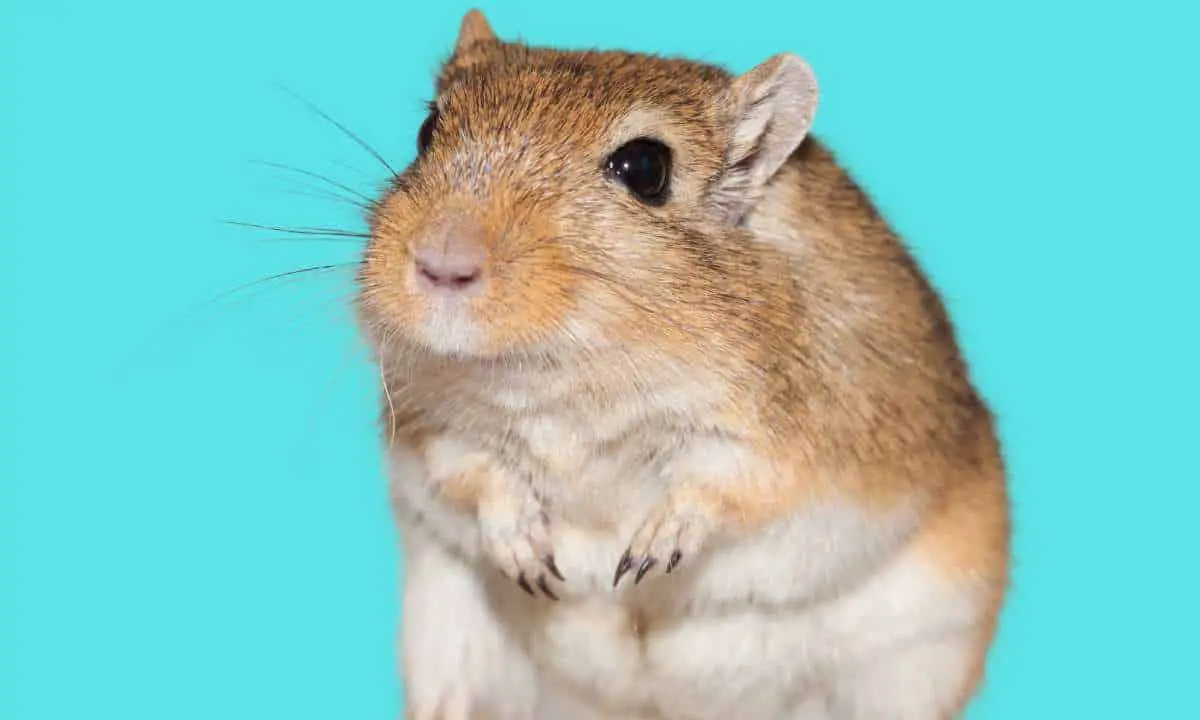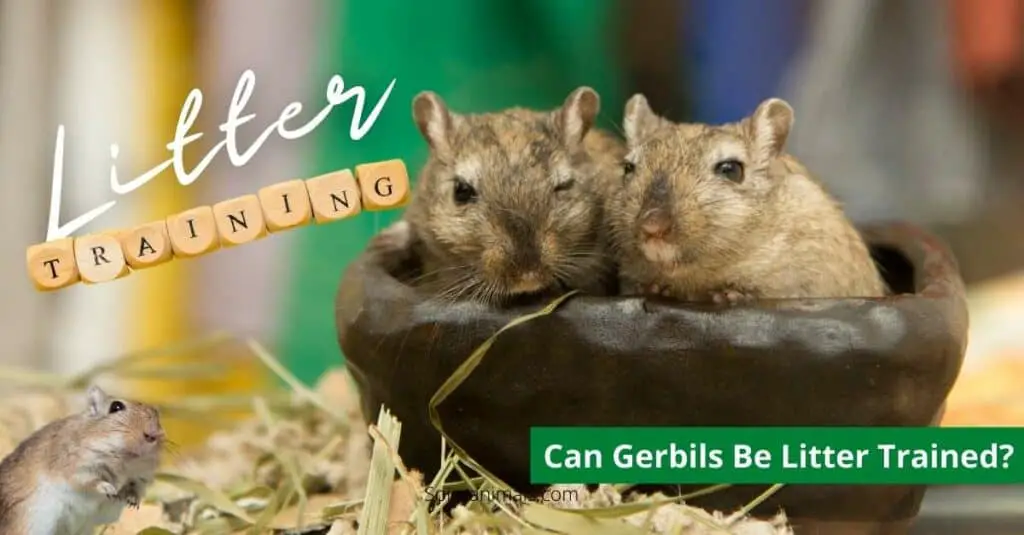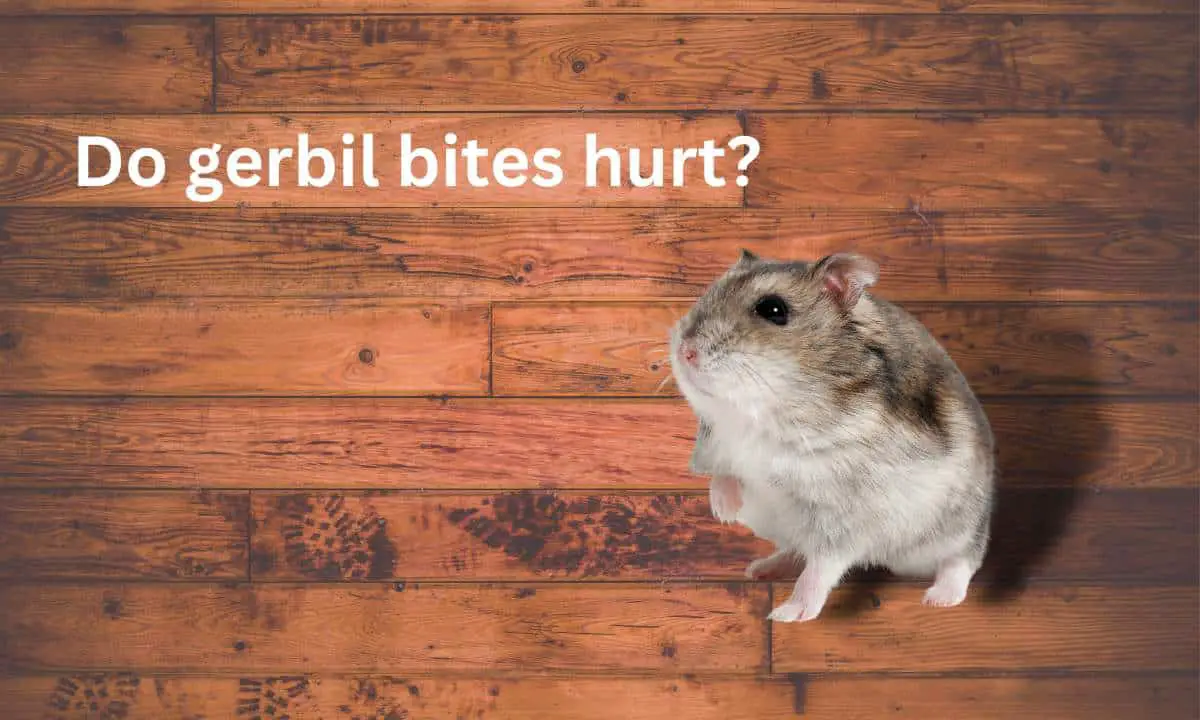Understanding Gerbil’s behavior can be a challenging task, but don’t worry – we’ve got you covered! In this article, we’ll dive into the fascinating world of these adorable rodents and explore some common behaviors you might encounter as a gerbil owner. By learning more about their behavior, you can provide better care for your furry friends. Keep reading to become an expert on gerbil behavior!”
Table of Contents
What are gerbils?
Gerbils are small, active rodents native to deserts in Africa and Asia. They live in colonies with a clear hierarchy, with a male and female dominant “alpha” pair leading the group. Gerbils are social animals known for their reputation as friendly, interactive pets.
Gerbils have become well-established as household pets and are unique for their tail shape. When observed from the side, it appears the gerbil’s tail runs straight down toward its back legs; when viewed from above, the tail appears curved due to its flexibility. A full-grown gerbil will reach up to 5 inches in length and weigh between 20-45 grams on average.
Male gerbils tend to be larger than female gerbils and they also have more distinctive genitalia visual cues that can be seen quite clearly with the naked eye when they stand up on their hind legs. Alongside this sexes have different facial markings which tell you if it is male or female. Gerbils display many behavioral traits that can help pet owners understand their personalities and distinguish how individual gerbils may interact within a colony or with people.

Why do people keep gerbils as pets?
Gerbils are an increasingly popular pet choice for people of all ages. They have a mild temperament and are relatively low-maintenance, making them easier to care for than larger animals such as cats or dogs. Gerbils also live longer lifespans than most other small rodents; their life spans range from 2-6 years in captivity, depending on the care they receive as pets.
Gerbils can be good pets not just because they require minimal attention, but also because they can be very amusing to watch! They are social and interactive animals that live in groups in the wild and will usually make friends with their owners. When they’re handled too much or ignored, however, gerbils can become stressed out or irritable; so it’s wise to observe them carefully and give them breaks. Additionally, gerbils are quite active creatures; they love running on exercise wheels and going exploring in their leisure time. If given plenty of toys, tunnels, mazes, and other forms of playtime entertainment, a gerbil will keep itself busy for hours!
Perhaps the most important reason why someone would choose to keep a gerbil is because of their low environmental impact compared to other pets. Not only do gerbils not require large amounts of space- instead living comfortably in a simple cage with some bedding- but it’s possible for gerbil owners to go easy on their wallets too by simply collecting items from nature like twigs and leaves for toys instead of buying them from stores. Additionally, Gerbils waste products have fewer odors than those produced by many other household pets like cats or dogs which may deter some potential pet owners who are particularly sensitive to smells. All these reasons make gerbils great pets!
Gerbil Behavior
Gerbils make great pets and are quite unique in their characteristics and behaviors. If you want to understand your gerbil better and learn how to read its behaviors, then understanding its habits and behaviors is key.
In this article, we will be delving into the basics of gerbil behavior and habits, so you can better understand and appreciate your furry friend.
Social Behaviors
Gerbils are social rodents that naturally form large family-like communities in the wild. They’re highly interactive and playful animals that need a lot of mental stimulation to stay interested and active. When kept as domestic pets, they also require lots of regular attention and handling to stay healthy and happy. Bonding with your gerbil is important to ensure a good relationship, as it will enable it to become more trusting, friendly, and cooperative.
Gerbils do not hibernate during winter but typically remain active year-round regardless of temperature changes in their environment. In terms of mating, gerbils are able to reproduce from the age of 3 months onwards, with females able to have litters approximately every 28 days for 5-6 months at a time before entering a lapse where no new babies are born. Once at adulthood, male gerbils can reach up to 4 inches in length while female gerbils remain slightly smaller at around 3 inches on average.
Social behaviors displayed by gerbils include:
- Grooming: This involves running their paws along their body while cleaning themselves or other members of the group they live with.
- Cuddling: Just like many other rodents, gerbils enjoy snuggling up into warm spots such as blankets or shirts after handling them for some time.
- Social Interaction: Gerbils actively seek out companionship and enjoyment from one another whether this means engaging in play fights or performing simple behaviors together like eating or grooming each other.
- Dominance Showing: Gerbils often display dominant behaviors such as chasing each other around an enclosure or raising their own hackles when confronted with unfamiliar animals outside their group – this is normal behavior for them!
Grooming
Gerbils are known for their fastidious grooming habits and have some particularly unique grooming traits that set them apart from other rodents. They start by licking the fur of their face, spreading the saliva over each hair, and using their tongue to comb the fur back into place. After grooming its head and neck, it goes on to groom its back, sides, and tail in this same way. This starts with licking the fur to coat it in saliva before brushing its teeth through it.
An interesting thing to note is that gerbils also groom each other; this is both social behavior and helps keep clean any hard-to-reach places on their bodies. Another common behavior that can be seen during grooming is sand bathing; gerbils will use sand or soil as a kind of exfoliant when scrubbing themselves clean — usually prior to laying down for a nap — shaking off any excess dirt afterward like cats do when they bathe in water.
Next time you spend time with your gerbil, take a minute or two to watch them while they groom as an insight into why hygiene plays such an important role in their day-to-day life!
Eating Habits
Gerbils are omnivorous and forage for food in their natural habitat. In captivity, they may eat manufactured gerbil food pellets, seeds, nuts, fruits and vegetables such as apples and carrots. They also will eat live prey such as insects. Their eating habits are dependent on the season of the year; they consume more when cooler temperatures prevail in the winter months and less in the summer months.
A gerbil’s diet should be enriched with red mealworms or crickets twice a week to provide additional protein to their normal diet. Mealworms should be fed in moderation due to their high levels of fat content. Vegetables and fruits should also be given frequently to make sure the gerbils receive other essential vitamins and minerals which their diets may lack. It is important to always remember that gerbils need fresh clean water every day from a rodent or insect drinker.
Each individual gerbil has distinctly different tastes as far as what they like to eat; some favor certain fruits while others prefer certain vegetables. Therefore, it is important to give these animals a variety of treats so they can receive a balanced diet comprising all the essential nutrients that are necessary for survival and healthy growth.
Sleep Habits
Gerbils are mostly active during the day, but take plenty of regular naps throughout the day. When it’s time to sleep, gerbils will typically hide away in a nesting box or under a pile of shavings. They can sleep for 6-10 hours at a stretch, though they may also wake up occasionally and check their environment before snuggling back down into their cozy spot and dozing off again.
At night, gerbils may also become active to search for food or explore their habitat. If you find your gerbil stirring around its cage during the evening hours, don’t be alarmed; this is normal behavior for them.
Gerbils need between 10 and 12 hours of sleep each night in order to stay healthy and content. If your gerbil isn’t getting enough shut-eye due to a loud environment or too much light exposure at night (from electronics or house lights), try keeping him in a quieter area without any lights after dark so he can get adequate rest each night.
Interacting with Gerbils
Interacting with gerbils can be an incredibly rewarding experience. It’s important to understand gerbil behavior and habits before bringing a gerbil into your home.
This guide will help you understand the basics of gerbil behavior so that you can properly care for your pet gerbil.
How to Handle a Gerbil
Correct handling of a gerbil is key to developing a bond and maintaining the animal’s trust. Start small, allowing the gerbil to come to you initially rather than immediately putting your hand in its cage. Speak softly and slowly, reassuring it that you pose no harm.
When first introducing your hands into the cage environment, allow your gerbil ample time to sniff your fingers or hand before you attempt to pick it up. Once accustomed to your presence and gently touching its body, use two hands with one supporting its body from underneath. Take extra care not to squeeze too tightly as this can cause stress for the creature given its fragile nature. When carrying them about, be sure your hands are close enough to the body that they feel secure and keep the movement within reason so as not to frighten them.
If at any point during handling the gerbil becomes timid or overwhelmed, stop moving immediately and placed on a flat surface for further comfort and familiarity before continuing interaction. The more time you spend getting comfortable with each other, both inside and outside of the cage environment, the more relaxed he will become when approaching him each time thereafter.
How to Bond with a Gerbil
Bonding with a gerbil is essential for creating a long-lasting relationship. It takes time to develop trust, and the more time you spend together, the stronger the bond will be. Some of the most important types of interactions that can help to form good relationships between humans and gerbils are listed below.
Positive Reinforcement: Positive reinforcement refers to rewarding a gerbil for exhibiting desirable behaviors. This could be anything from petting, playtime, or treats when they do something you like. This helps to create consistency in their behavior and encourages them to repeat it.
Interactive Play: Gerbils can be quite active and love interactive playtime with their owners. Take advantage of their curiosity by providing them with safe toys such as mazes or balls they can explore and play with, as this will help stimulate them mentally and strengthen your bond with them.
Create Habitats: Gerbils need ample room within their cage to explore, hide out from the noise and chase each other around even when you’re not in the room playing with them – so give it to them! Use items like cardboard boxes or burrowing objects so your gerbil has space to explore on its own.
Quality Time: As stated earlier, bonding time is vital if you want your relationship with your gerbil to last. A relaxed atmosphere where all stressors have been removed is best; sit at floor level rather than above them (so they don’t feel intimidated) while doing things such as gentle petting or feeding through hand feeding – this helps create positive interactions between human handler and pet!
How to Train a Gerbil
Gerbils are some of the most entertaining and rewarding pets you can have. Not only are gerbils incredibly adorable but they can also be trained to recognize their name and perform exciting tricks like jumping over obstacles and running through laps. Training a gerbil requires consistency, patience, and an understanding of its behavior. With these tips in mind, you can learn how to train your gerbil and enjoy spending quality time with it:
Start by teaching your gerbil its name through repetition using slow-paced words that are easy for it to understand. Use treats as reinforcement for correct responses so that it associates them with positivity. Make sure to use the same treat every time so that it learns which type of reward awaits when it performs the desired behavior.
When your gerbil starts recognizing its name, introduce hand signals associated with rewards or treats; once your gerbil begins trading behaviors with rewards, you know that it is ready for further training sessions. To ensure its safety while practicing new tricks, provide an enclosed area with no other animals around to distract or frighten the adorable creature.
Begin by teaching simpler tricks such as retrieving small objects like pieces of paper or balls — first demonstrate how you would like your gerbil to act and then reward it when it does something similar. Don’t forget to repeat positive words whenever your pet performs a trick correctly! As time goes on and more complex tricks are introduced successfully, increase the difficulty level via prompting as opposed to repeating tasks over again; this will help keep training sessions stimulating and fun!
Keep calm at all times while training sessions or lessons take place — loud noises may scare or confuse your pet so stick with a consistent tone at all times while practicing new behaviors or techniques with your gerbil! When encouraging positive behaviors, give rewards immediately after successful completion – this will reinforce what has been learned and make learning enjoyable for both parties involved!
Common Problems
Like any other pet, gerbils can have their share of health issues or behavioral problems. It’s important to be aware of the most common issues that Gerbils can have, so let’s start by taking a look at the most common problems gerbils can face.
From excessive digging to frequent biting, we’ll discuss how to identify and how to best address these issues.
Biting
Gerbils have powerful front teeth and may bite if threatened or surprised. Biting is uncommon however and does not necessarily mean that a gerbil is aggressive. Gerbils are naturally curious and testing the environment with their exploring teeth (especially when smelling objects) is normal behavior.
If a gerbil does bite, it is important to remain calm — more activity from the handler will only cause additional fear in the gerbil. So as soon as you recognize that your gerbil is about to bite, stop whatever you are doing and take your hands away slowly. If your gerbil continues to bite, try covering its eyes with a small piece of paper or cloth to distract it until it stops; this helps decrease its aggression while they become accustomed to the handler’s presence in its home.
It’s important to remember that if a gerbil isn’t used to human interaction it may be scared or uncomfortable in strange situations- which can lead to biting. For this reason, it’s recommended that you get two gerbils rather than one- not only will they have companionship during playtime but they’ll likely be less territorial when meeting new people and make for better pets overall. Proper socialization with consistent handling can help to reduce fear levels, improving confidence over time, which can make helping them acclimate easier on both owner and pet alike!
Digging
Digging is one of the most common behaviors of gerbils, and often it can seem that all your gerbil does is excavate tunnels in its cage. Although not a cause for concern, digging behavior should be understood and managed appropriately in order to keep your gerbil healthy and safe.
Digging can occur for a number of reasons, but the most common motivation is to create a comfortable living space for itself. Wild gerbils would usually dig intricate tunnels in order to attract a mate or protect themselves from threats. Domesticated gerbils may mimic this behavior by tunneling through cages, burrowing into bedding materials, or eagerly pushing around any objects left within their environment. In some cases, they will even enjoy making small burrows against warm surfaces such as clothing or skin!
This behavior can be beneficial as it gives your pet exercise, mental stimulation, and an outlet to satisfy its natural instincts. If you have multiple gerbils living together, burrowing can also provide them with areas for seeking privacy or protection when necessary. However, it’s important to remember that too much digging could potentially lead to health concerns such as overgrown nails or arthritis as your pet ages and its mobility decreases.
You can help curb excessive digging by providing your pet with plenty of toys and accessories that will encourage activity while taking up space within the cage itself — these items might include running wheels, hammocks, tubes, and tunnels which are fun ways to engage your pet while also limiting usage of any loose substrates like Sandor wood shavings. To further discourage counterproductive digging you could also add substrate-free sections into the cage where you can place toys like empty cereal boxes that your gerbil can safely chew through without risking damage to its mouth. Finally, always make sure there is plenty of nesting material available so that they always have an avenue through which they can maintain their health while still exploring their environment at the same time!
Chewing
Many gerbils like to chew, especially if they are kept in a cage with wooden objects. Not only does this help keep their teeth at a healthy length but it follows their natural instinct to explore and investigate the world around them. But what if your gerbil is chewing on inappropriate items such as wiring, furniture or even clothes?
The most likely cause of this behavior is boredom. If your gerbil isn’t getting enough stimulation from its environment it will seek out other sources which may be subversive or destructive in nature. To help prevent this problem, provide plenty of satisfactory surfaces for gnawing such as wood blocks specifically marketed for gerbils or the shelves and ramps that can be found in gerbil cages. Ensure that your pet has enough environmental enrichment materials such as toys, hiding places, and tunnels so that it can stay active and entertained. Finally, providing opportunities for socialization will also help alleviate boredom by helping your pet develop meaningful relationships with other members of its species.
Conclusion
Understanding gerbil behavior can be an important part of being a responsible gerbil owner. By studying their behaviors, you can better provide for their needs and meet their expectations.
In this article, we have discussed the basic behaviors and habits of gerbils and explored how to best manage them.
In conclusion, we can see that gerbil behavior can be a rewarding experience, with the right knowledge and care.



